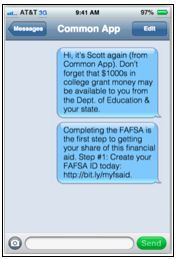The Common Application, used by nearly a million students each year to apply to college, is using young people’s favorite mode of communication—the text message—to help them meet crucial deadlines for financial aid.
The portal known to most as “the common app” has introduced a new feature into its system that will send text messages to students to “nudge” them into completing the Free Application for Federal Student Aid, or FAFSA. The common app piloted the text messages last

year. Now it will send them to most of the students who use the common app to apply to college.
The text reminders take on even more importance this year, since the rhythm of the federal financial-aid application cycle has changed. The FAFSA application is available online three months earlier than usual, and is easier to complete because it lets students report complete 2015 tax data, rather than partial 2016 tax information that would have to be updated later. This fall, the common app sent a round of text messages that were designed to alert students to these changes. They reached a half-million students around the country.
Research has shown that simple text reminders can help ensure that students who’ve been accepted to college actually take the steps to enroll. Missing that crucial step can mean a missed connection to higher education. Educators are now experimenting with using texts to send reminders about a variety of college-related tasks.
The White House has gotten on board, too. First lady Michelle Obama’s “Better Make Room” campaign includes a feature called “Up Next,” which allows students, families, and counselors to request a series of text messages that will prod them with questions about how they’re doing in their search for colleges, applying, and getting financial aid. Once they’ve enrolled in college, they get messages that try to connect them to helpful campus resources. And after they graduate, the messages shift focus on helping them work out their loan repayments.
The Common Application’s texting work is being led by Benjamin L. Castleman, an assistant professor at the University of Virginia who, with

Lindsay C. Page of the University of Pittsburgh, led the study that found that the use of text messaging can boost college-matriculation rates. (Castleman is a leading force behind the White House’s “Up Next” initiative, too.)
About 900,000 students use the common app to apply to college each year, and about 60 percent indicate that they need financial help to pay for college, according to the organization. Those are the students who received the FAFSA text reminders this fall.
Castleman is doing another related texting project in Texas. He’s teamed up with the Texas Higher Education Coordinating Board to design text messages tailored to specific subsets of students. For one group, students who are already in Texas colleges, texts will focus on reminders about how to reapply for financial aid each year. Another set of texts aims to re-engage students who completed some credits, but withdrew from college before finishing a degree. The third is designed to get the attention of high school students who applied to college but never enrolled.
